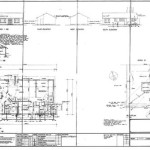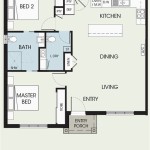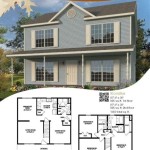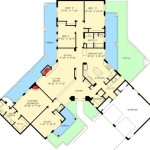House Plans With Closed Kitchens: A Functional Approach to Home Design
The concept of the closed kitchen, a distinct and physically separated cooking space, presents a viable alternative to the increasingly popular open-concept designs that dominate modern housing trends. While open kitchens prioritize social interaction and visual connectivity, closed kitchens offer several advantages related to functionality, noise reduction, and containment of cooking-related elements. This article explores various aspects of house plans incorporating closed kitchens, highlighting their benefits, design considerations, and suitability for different lifestyles.
Closed kitchens are defined by their separation from other living areas, such as the living room or dining room, through the use of walls and a doorway. This separation creates a dedicated space for food preparation and cooking activities, isolating these activities from the rest of the home. This design choice can be a strategic decision based on a homeowner's preferences, lifestyle, and specific needs.
Advantages of Closed Kitchen Designs
The primary advantage of a closed kitchen lies in its ability to contain cooking odors, noise, and visual clutter within the kitchen space. This is especially beneficial for individuals who frequently cook elaborate meals or those sensitive to strong aromas. The walls act as a barrier, preventing smells from permeating throughout the entire house, contributing to a more serene and comfortable living environment. Furthermore, the noise generated by appliances, such as blenders or dishwashers, is significantly reduced in the adjacent living areas.
Another key benefit is the ability to maintain a cleaner and more organized appearance in the open living area. With a closed kitchen, the visual clutter associated with food preparation, dirty dishes, and cooking utensils is kept out of sight. This allows homeowners to maintain a more formal and aesthetically pleasing living space, particularly when entertaining guests. Closed kitchens also provide more opportunities for dedicated storage solutions, as the walls offer ample space for cabinetry and shelving, maximizing storage space and minimizing visual disarray.
From a practical standpoint, closed kitchens can offer improved temperature control. When cooking, the heat generated from ovens and stovetops can raise the temperature of the entire house in an open-concept layout. However, in a closed kitchen, the heat is contained within the defined space, preventing it from affecting the comfort levels in other areas, potentially reducing energy consumption for cooling during warmer months.
Design Considerations for House Plans with Closed Kitchens
When designing a house plan with a closed kitchen, several crucial factors must be considered to ensure functionality and efficiency. The kitchen's size and layout should be carefully planned to accommodate the necessary appliances, countertops, and storage space. The placement of the kitchen within the overall house plan is also important. Ideally, it should be conveniently located near the dining area for easy serving and cleanup, and potentially near a back entrance for convenient grocery unloading.
Ventilation is a critical consideration in closed kitchens. Adequate ventilation is essential to remove cooking odors, smoke, and excess moisture. A powerful range hood that vents to the outside is highly recommended. Windows can also provide natural ventilation and bring in natural light, contributing to a more pleasant cooking environment. Planning for sufficient natural light is important, as closed kitchens can sometimes feel dark and confined without adequate illumination.
The layout of a closed kitchen can be customized to suit different needs and preferences. Common layouts include L-shaped, U-shaped, galley, and island kitchens. An L-shaped layout is efficient for smaller spaces, while a U-shaped layout provides ample countertop and storage space. A galley kitchen, characterized by two parallel countertops, is ideal for narrow spaces. An island can be incorporated into a closed kitchen to provide additional workspace and storage, but it requires a larger kitchen area to avoid feeling cramped.
Accessibility within the kitchen space is another important design element. The work triangle, which connects the sink, refrigerator, and stovetop, should be optimized to minimize unnecessary steps and maximize efficiency. Sufficient countertop space should be provided on both sides of the stovetop and sink to facilitate meal preparation. The placement of appliances should be carefully considered to ensure easy access and prevent congestion.
Suitability for Different Lifestyles and Home Styles
Closed kitchens are not universally suitable for all lifestyles and home styles. They are particularly well-suited for individuals or families who prioritize functionality and a clean, organized living space. Those who frequently entertain formal dinners or who prefer to keep the cooking process hidden from guests may find a closed kitchen more appealing. Closed kitchens can also be beneficial for individuals with allergies or sensitivities to cooking odors, as the separation helps contain allergens within the kitchen area.
From a stylistic perspective, closed kitchens can complement a variety of home styles. They are often found in more traditional or formal home designs, where a distinct separation between living spaces is preferred. However, they can also be incorporated into modern or contemporary homes, provided that the design is carefully executed to maintain a cohesive aesthetic. The choice of cabinetry, countertops, and flooring materials can significantly impact the overall look and feel of the kitchen, allowing it to seamlessly integrate with the rest of the house.
Families with young children may find that an open-concept kitchen offers better visibility and allows them to supervise children while cooking. However, a closed kitchen can provide a safer environment for children, as it limits their access to potentially hazardous cooking equipment and hot surfaces. The decision ultimately depends on the specific needs and priorities of the family.
The choice between an open or closed kitchen is a personal one. There are advantages and disadvantages to both designs. Thinking carefully about your lifestyle and desired level of functionality will lead to the right decision for your home. A closed kitchen offers a focused and contained space for preparing food, while an open kitchen emphasizes connectivity and social interaction.
Integrating a breakfast nook within or adjacent to a closed kitchen can offer a compromise between the formality of a closed space and the sociability of an open floor plan. This arrangement allows for casual meals and informal gatherings while still maintaining a degree of separation from the main living areas. Thoughtful placement of windows and doorways can also enhance the connection between the kitchen and other living spaces, creating a more inviting and versatile environment.
Ultimately, the selection of a house plan with a closed kitchen should be based on a thorough assessment of the homeowner's needs, preferences, and lifestyle. Understanding the advantages and disadvantages of closed kitchens, along with careful consideration of design elements, will enable homeowners to create a functional and aesthetically pleasing kitchen space that meets their specific requirements.
Maximizing Space and Light in Closed Kitchens
One common concern with closed kitchens is the potential for them to feel cramped and dark. However, strategic design choices can effectively mitigate these issues. Utilizing light color palettes for walls, cabinetry, and countertops can significantly brighten the space and create a sense of openness. Glossy finishes on cabinets and backsplashes can reflect light, further enhancing the brightness of the kitchen.
Proper lighting is crucial in closed kitchens. A combination of ambient, task, and accent lighting can create a well-lit and functional workspace. Recessed lighting provides overall illumination, while under-cabinet lighting illuminates countertops for tasks such as food preparation. Pendant lights above an island or breakfast bar can add visual interest and provide focused lighting for specific areas. Natural light should be maximized by incorporating windows or skylights whenever possible. If natural light is limited, consider using artificial light sources that mimic natural daylight to create a more pleasant environment.
Clever storage solutions are essential for maximizing space in closed kitchens. Utilizing vertical space with tall cabinets and shelving can significantly increase storage capacity. Pull-out shelves and drawers can make it easier to access items stored in the back of cabinets. Over-the-sink dish racks and under-cabinet organizers can free up countertop space. Incorporating a pantry, either within the kitchen or adjacent to it, can provide ample storage for food and kitchen supplies.

Traditional Homes With Closed Floor Plans Blog Eplans Com

Traditional Homes With Closed Floor Plans Blog Eplans Com

Traditional Homes With Closed Floor Plans Blog Eplans Com

We Re Making A Case For The Not So Open Floor Plans

Traditional Homes With Closed Floor Plans Blog Eplans Com

Traditional Homes With Closed Floor Plans Blog Eplans Com

Traditional Homes With Closed Floor Plans Blog Eplans Com

34 Best Closed Concept Plans Ideas House Floor

34 Best Closed Concept Plans Ideas House Floor
:max_bytes(150000):strip_icc()/__opt__aboutcom__coeus__resources__content_migration__treehugger__images__2017__02__plan-messy-6f18e692861642f4b1b17f419a462e42.jpg?strip=all)
The Case For Closed Kitchen








